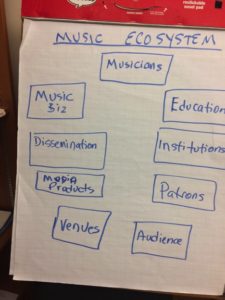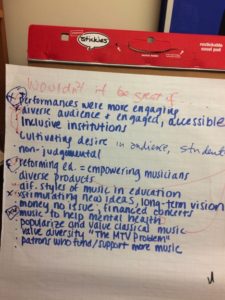This semester, 16 students in my class on Innovation and Collaboration class at the Yale School of Music are tackling the issue of the sustainability of classical music in the 21st Century in order to get closer to the Ideal World of Classical Music. These students are not just superb musicians but they also aspire to be cultural leaders who want to make a difference. Using the creative problem solving process and design thinking, students will be working in small collaborative project groups to generate and experiment with innovative solutions to some of the most pressing problems facing our field.
How does one decide on which problem to tackle?
Here are the 5 stages of our process:
- The Big Picture: Understand the Music Ecosystem
What does the Ideal World of Classical Music look like?
It is helpful to think of the music world as a self-sustaining ecosystem that can be described as follows (with thanks to Jeff Todd Titon’s blog:

2. The Ideal World and Your Mission
Using this as the backdrop, our students explored what they would IDEALLY like to see in the world of classical music. Our students had already created their personal mission statements in which they articulated:
- What do I do?
- For whom?
- How do they benefit?
Thus, they knew what part of the ecosystem they were most interested in and what audience they wanted to help.
In order to imagine the Ideal World of Classical Music, we used the phrase:
Wouldn’t it be great if…….
and then brainstormed about what we wished the music world would look like.
Our brainstorming process involved two stages:
- Brainwriting: each student wrote down 10 ideas of what the IDEAL world looked like for classical music
- We then had a group brainstorming session where each student was asked to share his or her favorite idea and then build on the ideas of the other students.
Here is the list that we generated:

3. Zeroing in on our Top Issues
With all these ideas swirling about, we needed a way to filter our list so that we could choose which Ideal State we were most interested in working towards.
We used 3 filters:
- Interest: How much do we care about working on this issue?
- Influence: How much impact do we have over arriving at a solution to this issue?
- Imagination: Which issue needs new thinking and is susceptible to an innovative solution?
Ultimately, we came up with the following ideal state for classical music:
Wouldn’t it be great if….
Performances were more engaging with stimulating new ideas and were accessible to a diverse audience educated in a wide array of musical styles and who valued classical music
This statement focused primarily on the audience and education parts of the ecosystem:
- Engaging performances
- Performances with stimulating new ideas
- Accessible performances
- Diverse audiences
- Audiences who are educated in a wide array of musical styles
- Audiences who value classical music
4. Avoid Groupthink
As we began to zero in on ideas for addressing these issues, I wanted to make sure that we were not prematurely dismissing other ideas. One of the fun parts of brainstorming is the energy that the group experiences as we share ideas. However, it is important not to lapse into “groupthink”, the phenomenon that occurs when members of the group conform to each other’s thinking and fail to make good decisions. Therefore, I checked in with the group to see if there were other parts of the ecosystem that they cared about. Sure enough, there was a second cohort of students who cared about the musicians in the ecosystem and wished that there were a more supportive community that shared their best practices around performance. They also cared about the way that musicians were trained, evoking the music part of the ecosystem.
5. Find Your Collaborators
Now that the students identified a few different paths towards creating the Ideal World of Classical Music, they generated project ideas which combined their personal missions with the parts of the ecosystem that they cared about the most. Students pitched their ideas in order to coalesce around a common vision so that each member of a project group would be equally invested in working on solving that problem.
Initially, the students had 5 project ideas:
- A community concert involving middle and high-school students and their parents in underserved communities to learn about the power of music and how to fund a music education.
- Mentoring middle-school students to show them how the arts can help them achieve.
- A CD of songs sung in multiple languages to encourage curiosity about different cultures and the freedom to express one’s heritage through music.
- Young and young-at-heart audiences who are looking for a fun, accessible enjoyable venue in which to hear music.
- Musicians around the world who wanted a better way to learn how to practice and go behind the scenes to learn from the experts.
We engaged in a “speed-dating” process whereby students interviewed each other to see which group they were most interested in joining. The discussion continued outside of class through a discussion board feature on our on-line assignment platform. Over the course of 10 days, the students refined their project ideas and broke down into 3 project groups to serve three audiences:
- Students and their parents in underserved communities who love arts but who lack the knowledge of how to pursue their interests and the confidence to do so and who would be mentored in the power of the arts to change lives.
- Young and young-at-heart audiences who are looking for a fun, accessible enjoyable venue in which to hear music and want something beyond the traditional classical music concert.
- Musicians around the world who want a better way to learn how to practice, join an open, supportive community of musicians to share best performances and go behind the scenes to learn from the experts.
Stay tuned for more as we develop the projects and learn more about how to innovate!
